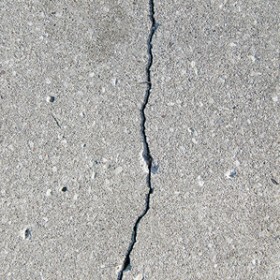Even the tiniest cracks on the surfaces of concrete structures can lead to big problems if they aren’t immediately repaired. Now researchers have demonstrated a sunlight-induced, self-healing protective coating designed to fix cracks on the surface of concrete structures before they grow into larger ones that compromise structural integrity.

Previous approaches to self-healing concrete systems have mostly focused on restoring strength to damaged concrete, says Chan-Moon Chung, a professor of polymer chemistry at Yonsei University in South Korea who led the research. His group chose to focus on protecting the surface, where tiny cracks can allow water, chloride ion from deicing salt or seawater, and carbon dioxide to penetrate the structure, which can lead to harmful deterioration.
The new coating contains polymer microcapsules, filled with a solution that, when exposed to light, turns into a water-resistant solid. The idea is that damage to a coated concrete surface would cause the capsules to break open and release the solution, which then would fill the crack and solidify in sunlight.
Researchers have developed a range of microcapsule-based, self-healing systems in recent years. Generally, they consist of a “healing agent,” often a polymer paired with a catalyst. The systems are designed so that damage brings the healing agent, originally in solution, into contact with the catalyst, which causes the healing agent to solidify. But “there are limitations to this system,” says Chung, such as the availability and cost of the catalyst. Since sunlight induces the key reaction in his group’s new coating, it has the advantage of being “catalyst-free” and potentially inexpensive, he says. Chung says the polymer his group chose as a healing agent is attractive because it won’t freeze even in very low temperatures, and is considered environmentally friendly.
To demonstrate the effectiveness of the coating, the researchers sprayed it on the surface of concrete samples, and used razor blades to apply small cracks. Scanning electron microscopy confirmed that the razor blade caused the microcapsules to release their contents, which filled the damaged area. After the researchers exposed samples to sunlight for several hours, further microscopy showed healing, whereas damaged areas in control samples remained unfilled. Finally, the researchers confirmed that samples with the new coating were far less vulnerable to water and chloride ion penetration than were controls.
Chung says his group’s next task is to determine the optimal composition of the coating, and show that it remains stable over an extended time. He says that, so far, the group has shown that the coating can remain stable for a year.
No comments:
Post a Comment